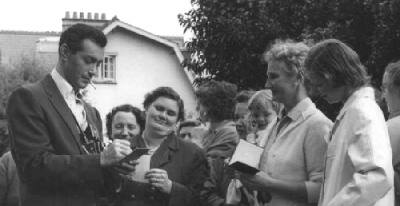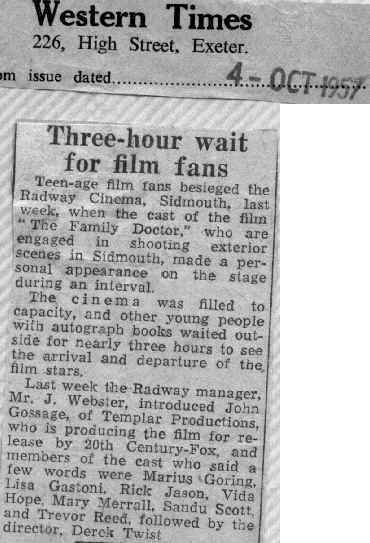Part Three: 1949
– 1959, Hollywood Studios
Prescription for Murder
I’d been paid a year’s salary to do one film, and toward the middle of the second year of my contract I was shipped off to England to make a picture under what was known as the Eady Plan. A little more than ten years after World War II, Europe still had not regained its financial stability. Currencies were frozen. The English, when they went abroad, were allowed to take only a small amount of money with them. The studios, all of whom had releasing branches as well as theater ownerships throughout Europe, found that they couldn’t take their profits out of those countries. So they made movies in England and on the continent, using American stars under contract to them, and exported the completed negatives back to the States for distribution.
Going to Europe was part work, part vacation. I discovered how much fun it was to travel when someone else pays for it.
Charlie Feldman had a representative in London, John Shepridge, a delightful gentleman and a damned good agent. John was married to a wealthy English lady of great good looks and humor. They owned a town home in Mayfair, the Beverly Hills of London, just across from Hyde Park, and they had the smallest Yorkshire terrior I’d even seen, named Mousetrap.
This little dog was one of the smartest I’ve ever known and was somewhat famous, since the Shepridges entertained the cognoscenti from all over the world. They had a pie table in their living room on which were placed dozens of gifts sent to "Mousie" from his friends. Everyone of them was a mousetrap, one in solid fourteen karat gold from an Indian Maharajah, a mink covered one, etc. John and his wife loved to travel and visited Paris quite often, where they owned an apartment. There was never any trouble taking an animal out of England, but there was a strict law, which is still on the books, about bringing in a dog: six months quarantine. John would carry a topcoat over his arm, "Mousie" was placed in a side pocket and told not to make a sound as they went through customs. They all went back and forth dozens of times, nobody the wiser. Mousie never let the cat out of the bag.
The picture, Prescription For Murder (also known as Doctor in the House) was based on a true story about a Doctor Adams who lured wealthy women into his practice, married them, and then did away with them. I played an American who goes to England to find his ex-wife, who has remarried (the doctor) and disappeared. Marius Goring, best remembered for The Red Shoes, played the doctor.
I got the biggest kick out of our director, Derek Twist (pictured left), though I never told him so. He was so typically British, he could have come from central casting. He always wore a sweater beneath his tweed jacket, a striped school tie, and he smoked cigarettes constantly from a black cigarette holder. He smiled at everything everyone said, and in order to agree with everyone (I never heard him disagree about anything) would respond with, "Precisely!" or more often, "Quite!" That was it, nothing more.
Derek would tell the cameraman the general setup of a scene, then retire to a neutral corner until the set was ready. As long as the actors didn’t bump into the furniture or wander out of camera range, everything played peachy for him, and, without further ado, he’d say, "Cut and print." Then he’d look around to see if the the camera operator and sound mixer agreed with him, nod his head and say, "Quite," and we’d go on to the next scene.
I fell in love with England and certain of its food, particularly a dish called whitebait. They are little fish, deep fried, about an inch-and-a-half long, served heaped on a platter and sprinkled with English malt vinegar. You eat a whole fish in one bite accompanied by a dry white wine: heaven!
Another winner was potted shrimp. Prepared in herbed butter, set in a ramikin and chilled, they were a perfect accompaniment spread on toast, with cocktails or as a first course at dinner. You’ll find a recipe for them at the back of this book.
Then there was something served with afternoon tea that I could never get enough of, called "clotted," or Devonshire, cream. It’s as thick as whipped cream cheese, but pure cream. A dollop of it is spread on a scone and topped with strawberry jam. The whole thing melts in your mouth. Just recently, I discovered it in my local super market, in a small, hermetically sealed jar: English Double Devon Cream. I bought a jar, along with some Robertson’s English strawberry preserves (nowhere near as sweet as American-made and much fruitier), took it home, baked some scones, and with a pot of English tea had a great late afternoon snack.
When the film finished shooting, we took a five-day holiday in Paris. John and his wife had entertained us royally, so I sent them a case of good wine. He, in turn, made reservations for us at a small hotel that sported a birdcage elevator and only forty rooms, each one furnished with priceless antiques. He also gave us a list of restaurants in which to eat and suggested what would be the best dish to order at each one.
Pictured right: Marius Goring and Rick Jason filming in England. Rick Jason said, "My director used a cigarette holder, so, of course, I did, too. Even passed out, my character never let go the cigarette holder.

